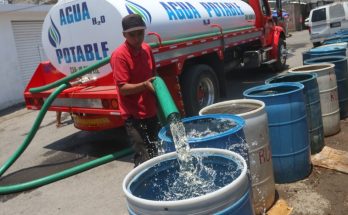By Alejandro Angulo
Due to the abuse and waste of water in Las Vegas, Nevada, in the United States, where approximately 2.3 million people live in an arid valley and where around 40 million tourists visit its enormous casinos and hotels every year drastic measures have been taken. In Nevada, however, less than 2% of the water from the dried-up Colorado River can be used. These measures range from prohibiting lawn irrigation to limiting the size of private pools.
As part of these measures, the Water Police was created who patrol from early morning in search of broken sprinklers and leaking hoses. The Water Police film the infractions before placing a flag in the yard for first-time offenders or before issuing fines for repeat offenders.
In fact, the main enforcement mechanism is based on citizen reports of water wastage resulting in 20 to 50 visits per day. It is estimated that by 2027, watering grass or decorative lawns will be prohibited except for single-family residences. Furthermore, the authorities in Las Vegas have created economic incentives by offering three dollars per square foot (0.30m) to homeowners who remove and replace grass with more water-efficient alternatives. This public policy and program have been attempted to be replicated in other U.S. cities such as Los Angeles and Phoenix but have proven difficult to emulate. An evaluation of this public policy has considered that «limited budgets and a limited ability to offer financial incentives in small cities can hinder water conservation programs.”
In Mexico and the state of Querétaro, efficient management of water resources has been proposed which requires an established legislative framework at the national and state levels to establish the principles of water resource management and the rules that must be applied at any scale: basin, sub-basin, region, or urban district.
These rules serve to define the conditions for water use, resource exploitation, capture requirements, compliance with concessions, discharge of contaminated water, procedures for obtaining authorizations for any action that has an impact on water media such as surface or groundwater and wetlands, planning procedures for water resource management, and control procedures for implementing the regulatory framework.
While in Mexico and Querétaro there is an inspection system whose general mission is to guarantee control and surveillance of compliance with regulations, it has been insufficient according to experience which shows that progress in water resource management and the qualitative, quantitative, and ecological state of these resources depends on the existence, observance, and proper functioning of a system.
So, what would a Water Police contribute that is different from the current inspection scheme? In cases such as the situation in Mexico City where water theft and control of wells by organized crime exists, it is clear that the inspection system is overwhelmed which would justify the existence of Water Police. On the other hand, it is important to consider that the present inspection system does not conduct daily surveillance patrols at various times which the Water Police could perform.
A system of permanent monitoring and surveillance contributes to deterring illegal behavior, and when it comes to water-related activities contrary to regulations it would be highly appropriate to have a Water Police that can impose fines similar to the way unauthorized parking is handled on public streets.
For a couple of years now, the National Water Commission (CONAGUA) in Mexico has considered the creation of a Water Police which would have among its main functions: ensuring the physical security of hydraulic infrastructure, supporting emergencies caused by weather phenomena, and actively participating in regional emergency plans. However, these measures fall short and fail to address the main issues.
As we mentioned earlier, the authorities in the city of Las Vegas resorted to these measures due to the phenomenon of water scarcity in their storage bodies or water sources, that is, the water crisis and the reduction of water volume in various uses to achieve a certain level of availability for all. Therefore, perhaps in Mexico and Querétaro, there is still time before considering the creation of a Water Police.
On the other hand, in Spain the Water Police is responsible for controlling pollution, illegal extractions, or the usurpation of public watercourses.
Certain approaches indicate that in the overall organization of the Water Police the principle of subsidy should be applied: while the national framework is necessary, especially to ensure that all citizens receive equal treatment under the law, decisions regarding the implementation of the Water Police (authorizations, fines, and so forth) should be made at a decentralized level under the responsibility of local state services as close as possible to the place where the activity requiring surveillance takes place.
There are various conceptions regarding this matter. For example, in France, the specialized police known as the Water Police are composed of an administrative police force under the authority of the prefect of the department (Ministry of the Interior) and a judicial police force under the authority of the public prosecutor (Ministry of Justice). The French Biodiversity Agency (Ministry of the Environment) provides operational and technical support to these two authorities particularly through the competencies of its environmental inspectors. At the national level, the Water Police depends on the Ministry of the Environment (French Biodiversity Agency) and is implemented at the regional and local levels through regional and departmental directorates.
Considering these various conceptions, it may be more feasible to have an environmental police force that also ensures surveillance and enforcement of water-related aspects.




